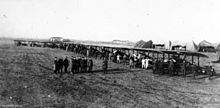Alan Rice-Oxley
Piloting Camel D8240, he and Captain Cedric Howell engaged a formation of between ten and fifteen Austro-Hungarian aircraft in proximity to the town of Feltre.
In the ensuing dogfight Rice-Oxley destroyed two of the enemy, and for his conduct in this action was awarded the Distinguished Flying Cross.
[11] Rice-Oxley was transferred to the RAF's unemployed list on 26 March 1919,[15] and relinquished his commission in the King's Shropshire Light Infantry on 30 September 1921.
[16] In 1921 Rice-Oxley emigrated to North Borneo to join the armed constabulary there,[17] and was appointed as an officer of Class B in the following year, with the rank of captain.
[18] His duties included showing visitors around and, in 1926, while motoring with the author Somerset Maugham, Rice-Oxley came across a 13-foot (4-metre) snake and killed it with his malacca cane.
[21] Post-war, he returned to Britain and was working as a dairy farmer at Knowle Farm, Uploders, Dorset, when he died on 21 July 1961.
